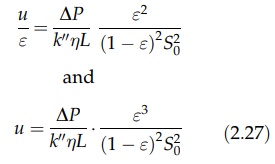Flow of Fluids Through Packed Beds
| Home | | Pharmaceutical Technology |Chapter: Pharmaceutical Engineering: Fluid Flow
Fluid flow analysis through a permeable bed of solids is widely applied in filtration, leaching, and several other processes.
FLOW OF FLUIDS THROUGH PACKED
BEDS
Fluid
flow analysis through a permeable bed of solids is widely applied in
filtration, leaching, and several other processes. A first approach may be made
by assuming that the interstices of the bed correspond to a large number of
discrete, parallel capillaries. If the flow is streamline, the volumetric flow
rate, Q, is given for a single capillary by equation (2.14),

where
l is the length of the capillary, d, its diameter, ΔP is the pressure drop across the
capillary, and η is the viscosity of the fluid. The length of the capillary
exceeds the depth of the bed of an amount that depends on its tortuosity. The
depth of bed, L, is, however,
proportional to the capillary length, l,
so

where
k is a constant for a particular bed.
If the area of the bed is A and it contains n capillaries per unit area, the
total flow rate is given by

Both
n and d are not normally known. However, they have certain values for a
given bed, so

where
K = d4n/k. This constant is a
permeability coefficient, and 1/K is
the specific resistance. Its value characterizes a particular bed.
The
postulate of discrete capillaries precludes valid comment on the fac-tors that
determine the permeability coefficient. Channels are not discrete but are
interconnected in a random manner. Nevertheless, the resistance to the passage
of fluid must depend on the number and dimensions of the channels. These
quantities can be expressed in terms of the fraction of the bed that is
void—that is, the porosity—and the manner in which the void fraction is
distributed. With reference to a specific example, water would flow more easily
through a bed with a porosity of 40% than through a bed of the same material
with a porosity of 25%. It would also flow more quickly through a bed of coarse
particles than through a bed of fine particles packed to the void fraction or
porosity. The latter effect can be expressed in terms of the surface area
offered to the fluid by the bed. This property is inversely proportional to the
size of the particles forming the bed. Permeability increases as the porosity
increases and the total surface of the bed decreases, and these factors may be
combined to give the hydraulic diameter, d0, of an equivalent channel, defined
by
d0 = Volume of voids / Total
surface of material forming bed
The
volume of voids is the porosity, and the volume of solids is 1 - ε. If the specific surface area, that
is, the surface area of unit volume of solids, is S0, the total
surface presented by unit volume of the bed is S0(1 - ε). Therefore,

Under
laminar flow conditions, the rate at which a fluid flows through this
equivalent channel is given by equation (2.14) as

The
velocity, u’, in the channel is
derived by dividing the volumetric flow rate by the area of the channel, k’d’2. Combining the
constants produces,

This
velocity, when averaged over the entire area of the bed, solids, and voids,
gives the lower value, u. These
velocities are related by the equation u
= u’e. Therefore,

Substituting
for d’ by means of
equation (2.26) gives

In
this equation, known after its originator as Kozeny’s equation, the constant k’ has a value of 5 ± 0.5. Since Q = uA, where A is the area of the bed,
equation (2.27) can be transformed to

This
analysis shows that permeability is a complex function of porosity and surface
area, the latter being determined by the size distribution and shape of the
particles. The appearance of specific surface in equation (2.28) offers a
method for its measurement and provides the basis of fluid permeation methods
of size analysis. This equation also applies to the studies of filtration.
Related Topics
